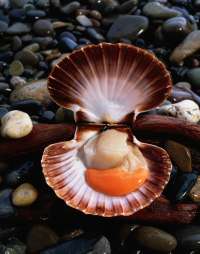
A scallop (/ˈskɒləp/ or /ˈskæləp/; from Old French escalope, meaning "shell") is a common name applied to many species of marine bivalve mollusks in the family Pectinidae, the scallops. Scallops are a cosmopolitan family, found in all of the world's oceans.
Many scallops are highly prized as a food source; the name "scallop" is also applied to the meat of these animals when it is used as seafood. The brightly colored, fan-shaped shells of some scallops, with their radiating fluted pattern, are valued by shell collectors, and have been used since ancient times as motifs in art and design.
Anatomy
Muscular system: Like the true oysters (family Ostreidae), scallops have a central adductor muscle, and thus the inside of their shells has a characteristic central scar, marking the point of attachment for this muscle. The adductor muscle of scallops is larger and more developed than that of oysters, because they are active swimmers; some species of scallops are known to move en masse from one area to another. In scallops the shell shape tends to be highly regular, and is commonly used as an archetypal form of a seashell.
Eyes: Scallops have up to 100 simple brilliantly blue eyes arranged around the edges of each of their two mantles like strings of beads. They are reflector eyes, about one millimeter in diameter, with a retina that is more complex than those of other bivalves. Their eyes contain two retina types, one responding to light and the other to abrupt darkness, such as the shadow of a nearby predator. They cannot resolve shapes, but can detect changing patterns of light and motion.
Reflector eyes are an alternative to those with a lens, where the inside of the eye is lined with mirrors which reflect the image to focus at a central point. The nature of these eyes means that if one were to peer into the pupil of an eye, one would see the same image that the organism would see, reflected back out. The scallop Pecten has up to 100 millimeter-scale reflector eyes fringing the edge of its shell. It detects moving objects as they pass successive eyes.
Digestive system: Most scallops are filter feeders, and eat plankton. Incidentally, the plankton can include scallop larvae. They lack siphons. Water moves over a filtering structure, where food becomes trapped in mucus. Next, the cilia on the structure move the food toward the mouth. Then, the food is digested in the digestive gland, an organ sometimes misleadingly referred to as the "liver" but which envelops part of the esophagus, intestine, and the entire stomach. Waste is passed on through the intestine (which, near its terminus, enters and leaves the scallop's heart) and exits via the anus.
Nervous system: Like all bivalves, scallops lack an actual brain. Instead, the nervous system is controlled by three paired ganglia located at various points throughout its anatomy. These are termed the cerebral ganglia, the pedal ganglia, and the visceral ganglia. All are yellowish in color; the visceral ganglia are by far the largest and most extensive of the three.